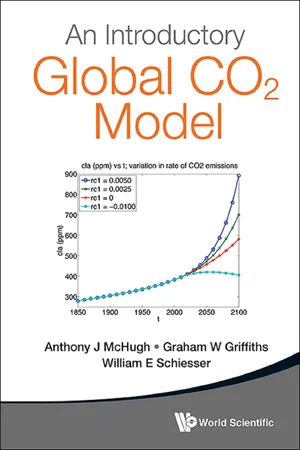
An Introductory Global CO2 Model
(with Companion Media Pack)
Anthony J McHugh, Graham W Griffiths, William E Schiesser
- 200 pages
- English
- ePUB (mobile friendly)
- Available on iOS & Android
An Introductory Global CO2 Model
(with Companion Media Pack)
Anthony J McHugh, Graham W Griffiths, William E Schiesser
About This Book
The increasing concentration of atmospheric CO 2 is now a problem of global concern. Although the consequences of atmospheric CO 2 are still evolving, there is compelling evidence that the global environmental system is undergoing profound changes as seen in the recent spike of phenomena: extreme heat waves, droughts, wildfires, melting glaciers, and rising sea levels. These global problems directly resulting from elevated atmospheric CO 2, will last for the foreseeable future, and will ultimately affect everyone.
The CO 2 problem is generally not well understood quantitatively by a general audience; for example, in respect of the increasing rate of CO 2 emissions, and the movement of carbon to other parts of Earth's environmental system, particularly the oceans with accompanying acidification. This book therefore presents an introductory global CO 2 mathematical model that gives some key numbers — for example, atmospheric CO 2 concentration in ppm and ocean pH as a function of time for the calendar years 1850 (preindustrial) to 2100 (a modest projection into the future). The model is based on seven ordinary differential equations (ODEs), and is intended as an introduction to some basic concepts and a starting point for more detailed study.
Quantitative insights into the CO 2 problem are provided by the model and can be executed, with postulated changes to parameters, by a modest computer. As basic calculus is the only required mathematical background, this model is accessible to high school students as well as beginning college and university students. The programming of the model is in Matlab and R, two basic, widely used scientific programming systems that are generally accessible and usable worldwide. This book can therefore also be useful to readers interested in Matlab and/or R programming, or a translation of one to the change.
Contents:
- Model Structure
- Model Equations
- Model Parameters
- Computer Routines
- Main Programs
- Plotting Routines
- ODE Routines
- Emissions Rate Routines
- Base Case Model Output
- Ocean Chemistry
- An Interpretation of Dimensionless ODEs
- Calculation of pH
- Global CO 2 Concentration
Readership: Students (undergraduate and above) and members of the public interested in/concerned with long-term environmental change. Key Features:
- A basic model for the global CO 2 problem
- Routines for the model in source code that can be used in a quantitative study
- (1) and (2) provide insights into the global CO 2 problem that are otherwise not available from a static description based on the past and current literature
Frequently asked questions
Information
